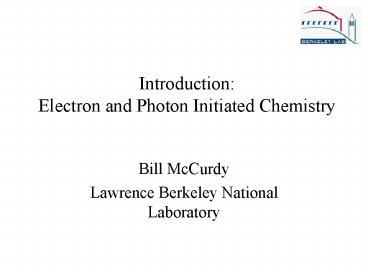Introduction: Electron and Photon Initiated Chemistry - PowerPoint PPT Presentation
1 / 9
Title:
Introduction: Electron and Photon Initiated Chemistry
Description:
Classic model of theoretical chemistry -- Electronic structure separate from dynamics ... Quantum or classical dynamics calculations of rates. Nonclassic ... – PowerPoint PPT presentation
Number of Views:20
Avg rating:3.0/5.0
Title: Introduction: Electron and Photon Initiated Chemistry
1
IntroductionElectron and Photon Initiated
Chemistry
- Bill McCurdy
- Lawrence Berkeley National Laboratory
2
Electron and Photon Initiated Chemistry
- Classic model of theoretical chemistry --
Electronic structure separate from dynamics
- Quantum Chemistry calculation of potential
surfaces - Quantum or classical dynamics calculations of
rates - Nonclassic theoretical chemistry
- in the presence of ionizing radiation
- in electronic collisions in plasmas
- electronic structure and dynamics are inseparable
3
Continuum Electronic Structure --
- At energies of low temperature plasmas the
colliding electrons are indistinguishable from
those of the target molecules -- electron
correlation and dynamics are the same problem
Electron - CF4 collisions requiring 20,000
configurations per symmetry
Isaacs et al.
4
One and multi-photon photoionization
- Final state is described by an electron/molecular
ion scattering wave function. - Coupled final channels are electronic states of
molecular ion. - Full coupled dynamics important for
- inner shell processes (shake-up states and
satellites) - resonance regions (autoionizing states)
- Valence ionization of surface adsorbed species
O2
Lucchese et al.
CO
5
Electron (and Photon) Initiated Chemistry in
Extreme Environments
Applications of interest in both gas and
condensed phases and on surfaces
6
Chemistry in Extreme Environments is Important to
DOE
- Plasma processing of semiconductors and other
materials - Etchant gases (CF4, BCL3, HBr, Cl2, ...) are
unreactive until activated in a plasma. - Nuclear waste, e.g., the tanks at Hanford
- cascades from decay events liberate electrons and
ions and initiate new chemistry (inc. by electron
attachment) - Waste remediation -
- plasma destruction of toxics (scrubbers of flue
gases, destruction of chemical weapons ...)
7
NAS Report on Database Needs for Modeling and
Simulation of Plasma Processing -- CAMOS
- Electron collision cross section data are second
only to data on heterogeneous processes in their
importance to plasma processing - The lack of fundamental data for the most
important chemical species is the single largest
factor limiting the successful application of
models to problems of industrial interest
8
Chaotic Evolution of a New Initiative in
Computational Science for FY 2000
- SS
- DOE Strategic Simulation Initiative becomes the
Scientific Simulation Plan becomes SS - Joint NSF and DOE workshop held at National
Academy of Science (150 attendees) - Joint NSF/DOE preliminary report emerges
(http//rrbhpnt.asc.cise-nsf.gov/) with three
components Science, Technology and Integration - Presidents Information Technology Advisory
Committee (PITAC) Report First Draft Circulated - Emphasis on Computer Science and Technology
- Multiagency Initiative in Preparation
- Neal Lane, as head of OSTP given task to
coordinate multiagency initiative in response to
the PITAC report. - DOE and NSF Response Still in Process as of
10-9-98 !
9
Scope of Original DOE Scientific Simulation
Initiative (Proposed for FY2000)
- Two Major Thrust Areas
- Climate Prediction
- Combustion Modeling
- Basic Science Component
- Materials Science
- Computational Biology
- Fusion and Plasma Physics
- Other?
- Cross Cutting Technologies
- Computer Science for Problem Solving Environments
- Computer Science for Data Management/Visualization
- Applied Mathematics supporting thrust areas and
basic science - Platforms Total Capability of 80 Tflops (peak)
in 2003































